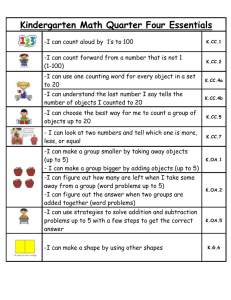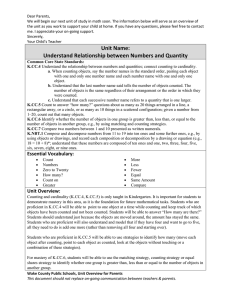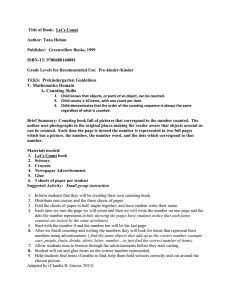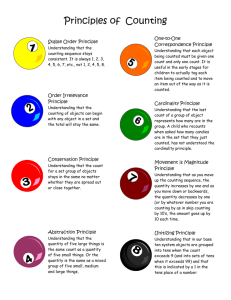Unit Name: Understand Relationship between Numbers and Quantity
advertisement
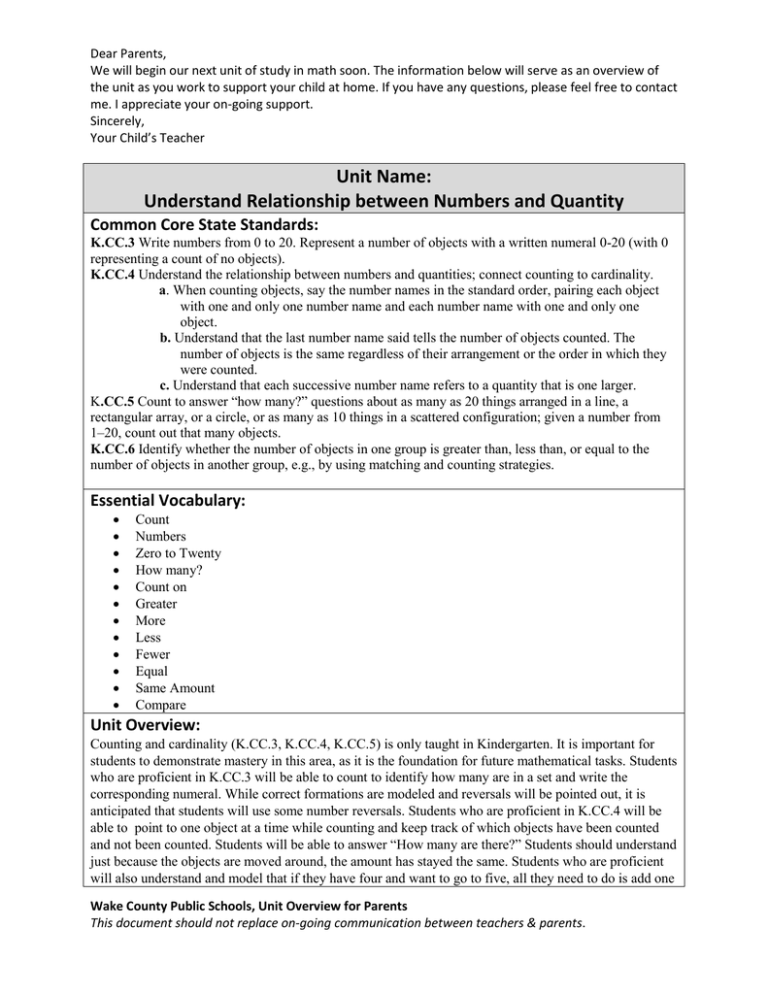
Dear Parents, We will begin our next unit of study in math soon. The information below will serve as an overview of the unit as you work to support your child at home. If you have any questions, please feel free to contact me. I appreciate your on-going support. Sincerely, Your Child’s Teacher Unit Name: Understand Relationship between Numbers and Quantity Common Core State Standards: K.CC.3 Write numbers from 0 to 20. Represent a number of objects with a written numeral 0-20 (with 0 representing a count of no objects). K.CC.4 Understand the relationship between numbers and quantities; connect counting to cardinality. a. When counting objects, say the number names in the standard order, pairing each object with one and only one number name and each number name with one and only one object. b. Understand that the last number name said tells the number of objects counted. The number of objects is the same regardless of their arrangement or the order in which they were counted. c. Understand that each successive number name refers to a quantity that is one larger. K.CC.5 Count to answer “how many?” questions about as many as 20 things arranged in a line, a rectangular array, or a circle, or as many as 10 things in a scattered configuration; given a number from 1–20, count out that many objects. K.CC.6 Identify whether the number of objects in one group is greater than, less than, or equal to the number of objects in another group, e.g., by using matching and counting strategies. Essential Vocabulary: Count Numbers Zero to Twenty How many? Count on Greater More Less Fewer Equal Same Amount Compare Unit Overview: Counting and cardinality (K.CC.3, K.CC.4, K.CC.5) is only taught in Kindergarten. It is important for students to demonstrate mastery in this area, as it is the foundation for future mathematical tasks. Students who are proficient in K.CC.3 will be able to count to identify how many are in a set and write the corresponding numeral. While correct formations are modeled and reversals will be pointed out, it is anticipated that students will use some number reversals. Students who are proficient in K.CC.4 will be able to point to one object at a time while counting and keep track of which objects have been counted and not been counted. Students will be able to answer “How many are there?” Students should understand just because the objects are moved around, the amount has stayed the same. Students who are proficient will also understand and model that if they have four and want to go to five, all they need to do is add one Wake County Public Schools, Unit Overview for Parents This document should not replace on-going communication between teachers & parents. Dear Parents, We will begin our next unit of study in math soon. The information below will serve as an overview of the unit as you work to support your child at home. If you have any questions, please feel free to contact me. I appreciate your on-going support. Sincerely, Your Child’s Teacher more (rather than removing all four and starting over). Students who are proficient in K.CC.5 will be able to use strategies to identify how many (move each object after counting, point to each object as counted, look at the objects without touching or a combination of these strategies). A students who is proficient in K.CC.6 will be able to use strategies to identify which group of objects has more or less (or if the groups are equal). Strategies/Skills: Students are expected to be able to identify how many are in a given set. It is important for students to develop a strategy that makes sense to them. To determine how many are in the set they may: Move the object as they count each Point to one object as counted Look without touching when counting Use one counting word for every object touched Students are expected to be able to identify which of two provided groups have more or less (or if they are equal). To compare sets students will use: Matching strategy Counting strategy Equal Shares strategy Video Support: Video support can be found on The WCPSS Academics YouTube Channel. http://tinyurl.com/WCPSSAcademicsYouTube o ES K Math Number and Quantity Relationships Using a Five Frame Additional Resources: If you have limited/no internet access, please contact your child’s teacher for hard copies of the resources listed in this document. NCDPI Unpacking Document: Kindergarten Unpacking Document Wake County Public Schools, Unit Overview for Parents This document should not replace on-going communication between teachers & parents.
